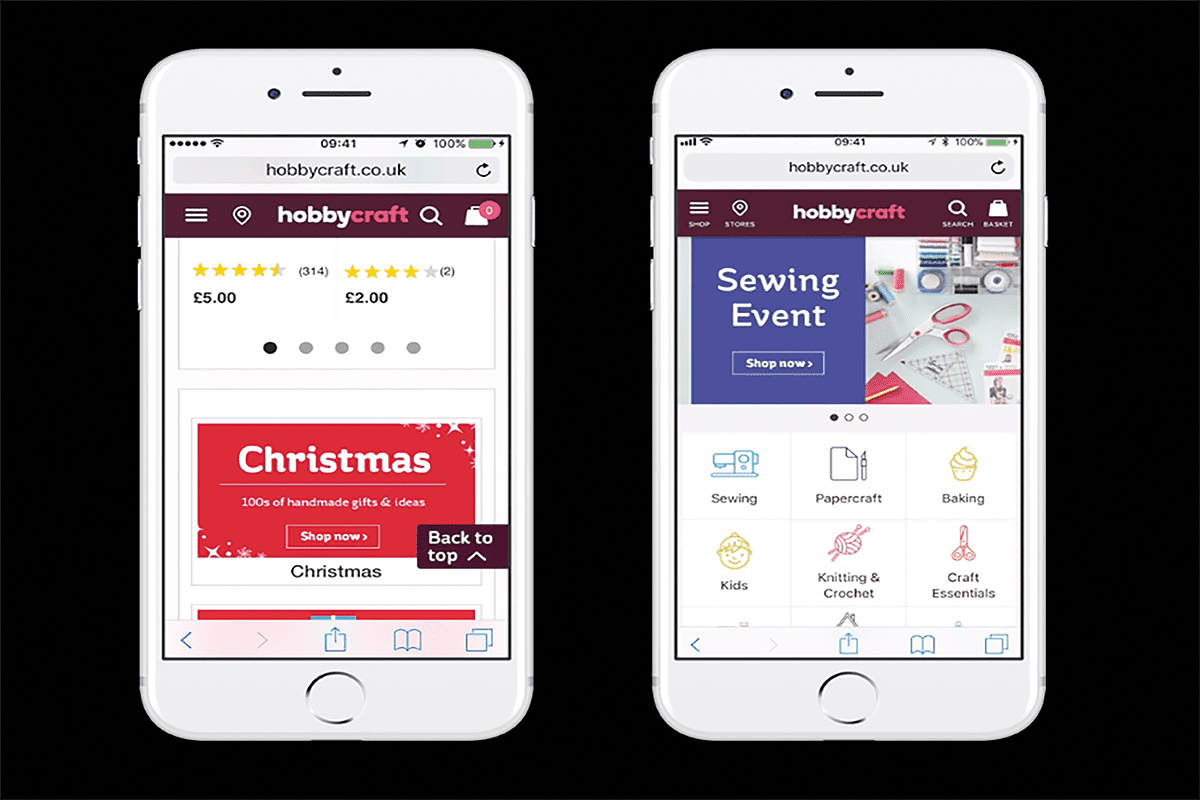The use of mobile in ecommerce continues to grow, with the US now catching up with the always more advanced UK market – but the way in which shoppers use mobile is changing and that is having a fundamental impact on the technology decisions that retailers need to make.
The move towards apps seems to have stalled, with shoppers increasingly using mobile websites to do their research, shopping and returns on their device. Apps serve a useful purpose for the loyal customer and are being used widely, even now showing up in search results. But for the more-canny consumer, the move is towards a web experience that looks like an app, but is more flexible and more suited to the on the fly nature of modern mobile shopping.
This is why technologies such as Progressive Web Apps (PWAs) and Accelerated Mobile Pages (AMP) are coming into their own in the mobile world.
More than 80% of IT, R&D and marketing professionals across the UK, US and Australia think that apps could be over – believing that all forward-thinking organisations will be implementing AMP and PWA within the next year.
So finds a pan-European study by tech research company Vanson Bourne for UK-based website hosting company WP Engine, which also suggests that four in five (81%) developers think that development costs of a native mobile application are higher than for a PWA, while AMP was among the least expensive solutions to implement ($189,991 on average), requiring the shortest time and the fewest developers.
But it is performance that is really starting to make retailers and IT developers think about PWA and AMP technologies as part of the mobile commerce paradigm.
According to Vanson Bourne, the top benefits anticipated of using AMP and PWA technologies include improved security (44%), increased traffic from mobile users (41%) and improved conversion rate (40%).
More speedy response times are also crucial, says Vanson Bourne. This is backed up by a separate study by cloud platform Akamai, which says that two seconds is the threshold for ecommerce website acceptability. However, says the Akamai report, just 17% of enterprises have an average website load time on mobile devices of under two seconds.
Mary Ellen Dugan, Chief Marketing Officer at WP Engine explains: “Consumers today aren’t just mobile first, they’re mobile only. Enterprise organizations are falling behind in terms of their ability to provide better, faster mobile experiences, putting themselves at great risk of losing customers and revenue.
When you factor in the real cost savings and performance increases realized by using AMP and PWA on WordPress, the results speak for themselves. The increased use of these two mobile technologies is resulting in much better mobile experiences at less than half the cost of apps and providing demonstrable benefits to consumers and an enterprise’s bottom line.”
And many retailers are failing to deliver this. According to a survey by Mobify in Q2 2018, many top retailer sites are failing to deliver the speed and agility needed in mobile. Mobify looked at page load benchmarks from 2,000 top ecommerce websites, a key indicator of meeting customer expectations, since Google reports that 53% of users will abandon a page that takes more than three seconds to load.
“Mobile usage in the UK is one step ahead of that in the US, so we wanted to look at ecommerce trends across the pond to predict what trends we will see next in the US,” says Amanda Naso, Mobify Senior Manager of Business Intelligence. “All signs point to shoppers spending more time and money on mobile, so better experiences, particularly speed, are vital.”
The report notes that mobile sessions surpassed desktop sessions in the UK in 2015, while the US reached the same tipping point a year later. Similarly, mobile revenue in the UK has been on par with desktop since the end of 2017.
Mobile and desktop revenue in the US are converging as well, with growth in both regions also showing parallels. With more users shopping and buying on mobile, and speed being a clear differentiator, one would assume there would be an increase in businesses giving more effort to their sites’ mobile performance.
“Not so,” says Naso. “We compiled a list of 2,000 top ecommerce sites and tested their page load speed to determine how the industry is measuring up to customer expectations. Only 10% of sites loaded in 3.1 seconds or less, while the median load time was 6 seconds.”
Naso continues: “The median first-page load time for AMP is 1.1 second, while the median subsequent page load time for a PWA is 1.4 seconds. Technology can help retailers and brands not only meet but exceed shopper expectations on the mobile web.”
USER EXPERIENCE
Opting for technologies such as PWA and AMP make the experience for the user on mobile much more straightforward and rapid and do actually lead to better conversions. Retailers such as Lilly Pulitzer and Lancôme achieve mobile revenue increases of 33% and 36% respectively with PWAs built on the Mobify Platform. With most users and orders on iOS today, retailers can now provide the high-converting PWA experience to this larger audience.
“Well-crafted PWAs have always worked across iOS and Android, but with the latest Apple Safari release now supporting service workers, iOS users will gain an even better shopping experience,” says Mobify CEO Igor Faletski.
One retailer that is certainly putting this into practice is Hobbycraft. In the run up to revamping its website, it tried out a PWA and saw transactions on mobile grow by 26% and mobile revenues up by 30%.
Hobbycraft, which has 90 stores and 3 million members of its online Hobbycraft Club, has long wanted to leverage mobile and the company has been working with Mobify to develop a mobile presence to bring together the technology and these many fans.
When Hobbycraft decided to build a Progressive Web App on the Mobify Digital Experience Platform, the team had three goals: capture traffic shifting to mobile devices, offer shoppers an app-like experience without requiring an app download and to increase key metrics like revenue per user. The approach has generated measurable revenue and put Hobbycraft at the forefront of retailers that are keeping up with changing shopper preferences through customer-first mobile commerce innovations.
“Our customers are project-based and motivated to get the supplies they need as fast as possible to get started on their next projects,” says Daniel Collier, Multi-Channel Development Manager, Hobbycraft. “We raised a challenge to find the best possible way to engage with our busy shoppers on-the-go, as well as deliver a best-in-retail purchasing journey.”
So, are we moving towards a world where apps are dead and where web-apps rule? Many think that, slowly, yes we are. According to Ben Morss, developer advocate at Google and a former New York Times engineer, “In order for web apps to earn a place on home screen, we need to make them reliable, even when the network isn’t. This has been one of the things holding back the web as an app platform. We’ve become conditioned to think that web app equals something that only works with a live network.”
In his view, these technologies start to make it more attractive to developers and users to have web-apps as they are just as rich, fast and reliable – and using the web as a platform means that they are easily updated and changed.
Don’t junk your app just yet, but it’s worth keeping an eye on when you may have to.
Know your AMP from your PWAs
So what are Accelerated Mobile Pages (AMP) and Progressive Web Apps (PWAs)? In short they are technologies developed by Google to be open source and to allow for faster loading and much richer mobile website experiences.
What are AMPs?
AMPs are just web pages, but they are ‘better’ than just any old webpage because they simplify the use of HTML coding to do things, which slows things down, and instead sees the pages and content cached on Google’s servers under a Google URL that the user doesn’t see. This means, with the pages cached they can be loaded whole and more rapidly, so long as the server they are cached on isn’t clogged up.
What are PWAs?
PWAs, by contrast, are webpages that are enhanced with other features that allow for the ability to offer app-like interfaces, faster transition between pages, the ability for app owners to send push notifications and access to content when offline. Users access PWAs via URLs just like they would with normal mobile browsing, but load the page in the background; allowing them to save it as an app icon on their mobile device. It also allows them faster browsing between pages if they are returning to the site or navigate beyond the first page.
PWAs +AMPs = the death of apps?
You may well be ahead of me here, but if you bring together these two enhancements – PWAs offering rich interfaces and faster access to content, with AMP generating pages much more rapidly – you have something that not only rivals the app experience, but bests it.
The advantage of doing anything over the web rather than in an app is that it can be more dynamic and can be changed and updated however and whenever the retailer wants.
Taken together these two things could well spell the death of the app.





